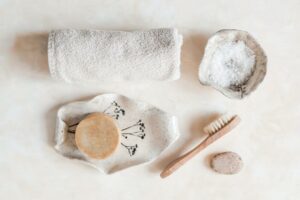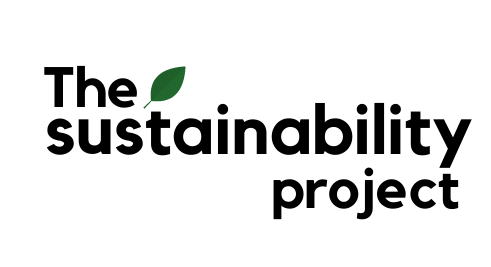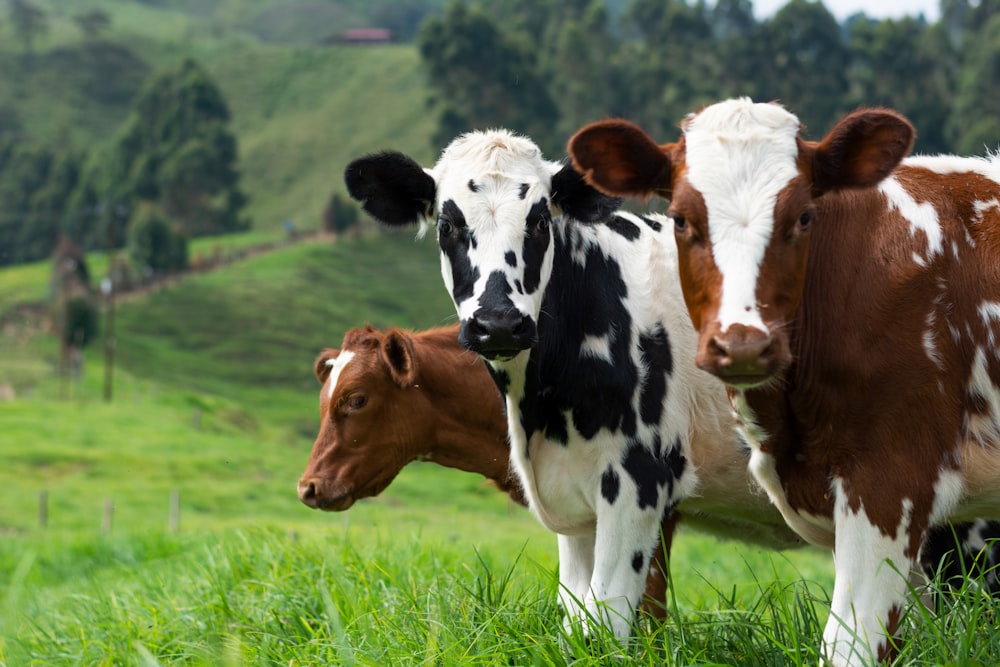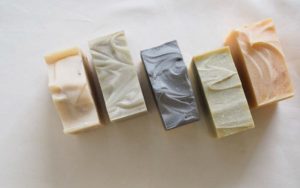Bar soap – the exquisite cake of goodness packed with a paradise of botanical, luxurious, and skin-rejuvenating ingredients to soothe your body and mind.
With more and more people embracing sustainability values, we have started to see a rising trend in soap bars (hooray!). As we celebrate the humble return of soap bars, do you think that all soaps are as natural as claimed?
Beyond the glorious aesthetic, a particular ingredient lies within some soap bars that makes them not as environmentally friendly as they seem – animal fat.
If you’re a big fan of soap bars or you’re still considering switching from liquid to soap bars, read along as we’re about to discover why soap bars containing animal fat fail to hit the mark for cruelty-free or vegan labels!
Revisiting the Soap History Timeline
Have you ever wondered – how was soap invented? Where and when did it happen? What was soap used for? How was soap manufactured in the past, and how has it changed over time?
Long story short – ancient Mesopotamians in 2800 B.C invented soap by boiling animal fats (derived from slaughtered cow, sheep or goat) with water and lye (an alkaline substance derived from wood ashes). This simple combination, also known as the cold-process soap-making method, led to a chemical reaction called saponification, which created a greasy and pungent solid which can remove dirt.
 Credits to: Human Society International
Credits to: Human Society International
You’ll be surprised to know that early soaps were never intended for our personal hygiene. Instead, it was commonly used for cleaning wool or cotton fibers in the textile industry. People back then cleaned themselves in water baths and smeared their bodies with scented olive oils, using a strigil (a metal scraper) to scrape off excess oil on their bodies.
Soap was only used for hygiene and healing (treating skin diseases) purposes in 1500 B.C when ancient Egyptians harvested alkali salts from the Vally of Natron and mixed them with animal fats & vegetable oils. Eventually, soapmaking improved over the centuries and animal fats were substituted with fruit oils to produce gentle, natural & scented soaps. That was when our Aleppo soap, a vegan and anti-inflammatory bar infused with aromatic laurel berry and olive oil came into the picture!
Fun fact: Soap used to be a luxury item in the early times due to the high cost of obtaining the ingredients!
The Animal Fat In Conventional Bar Soaps
Now to the main article topic: animal fat, otherwise known as lard, tallow, or sodium tallowate on the product label.
Lard is pork fat, derived from the fatty parts of a pig such as belly, shoulder & more.
Tallow or Sodium Tallowate is derived from animals’ suet, the hard fat surrounding the kidneys and loins of cattle, sheep & horses.
So, how is animal fat extracted from the animal itself?
Animal-lovers, I know we all hate to hear how animals suffer. I promise I’m going to go through the process of how animal fat is derived quickly.
Most lard and tallow are extracted through a rendering process as follows:
1. Before the fat-rendering process, fatty parts of the animal are chopped and ground into smaller pieces. This helps to remove as much meat as possible to accelerate the fat-rendering process.
2. The pieces of fat are then boiled in vats or cooked in steam digesters for several hours to melt the fat and separate them from the bones & meat. This process also removes impurities that cause tallow or lard to smell or rot.
3. White, waxy, tasteless, and odourless lard or tallow is then collected after skimming and centrifuging.
Sounds pretty energy-intensive, isn’t it? Not to mention that animal agriculture in Europe created 502 tonnes of methane emissions in 2018, which is comparable to Europe’s car emissions in the same year.
Regrettably, there is no verifiable evidence or statistics that prove whether animal fat is a by-product. Unless specified, no one knows for sure where the animals come from. No one knows whether the animals were slaughtered humanely for lard or tallow.
In addition, tallow and lard aren’t just used for making soaps. Your creamy moisturizers, mood-lifting candles, shaving creams, or lip balms may have animal fats on their ingredient lists, simply because of how hydrating and nourishing they are.
Given the benefits of tallow or lard in personal care products, what can guarantee that animals will be ethically slaughtered? Will they experience similar fates as minks for their fur?
Read more: Uncovering the Truth of Your Fake Eyelashes
Your Guide To A Sustainable Shower: How Can We Adjust?
Yes we know, it doesn’t take a snap of a finger to reduce bathroom waste or adjust our habitual routines. It takes time to change, and that’s totally understandable.
Going forward, here are some tips and tricks to lather up more sustainably!
1. Opt for Handmade & Plant-Based Bar Soaps
Did you know that commercially manufactured soaps today are synthetic detergents? These lab-engineered products usually contain synthesized animal fat and chemical additives such as artificial lathering agents, foam boosters, colours or fragrances that strip the moisture of our skin.
Handmade soaps, on the flip side, don’t contain these harmful chemicals. This is because they comprise glycerine – a humectant created from saponification that retains moisture to your skin. Furthermore, every bar is an artisan’s unique work of art – conscientiously & arduously formulated with more care & attention in small batches to ensure quality.
While certain handmade soaps do contain glycerine from animal sources, be sure to look out for “vegetable glycerine” or “plant glycerine” on the product ingredient list if you prefer them to be vegan! This is an indication of plant-based soaps that replace animal fat with plant butter (shea, avocado, mango etc) or vegetable oils (coconut, almond, olive, palm etc).
These earth-derived essentials rejuvenate and nourish your skin with a lower carbon footprint. Also, don’t forget to look out for sustainable plant oils that minimizes damage to the environment, such as pure olive oil and sustainably sourced palm oil 😊.
Read more: Let’s Talk about Palm Oil
This swap doesn’t just draw us closer to Mother Nature, but also reduces our bathroom plastic waste & carbon footprint at the same time.

2. Make Your Own Soap & Go Worry-Free From Animal Fat!
While we are on the topic of “handmade”, why not try putting on your creative hat and craft your own body soaps & shampoo from scratch? Plus, wouldn’t it be a meaningful family activity during this stay-home period?
With every DIY project, you call the shots as to what you put in. You never have to worry about having harmful chemicals on your skin. More interestingly, you can design your soap scent and shape to your own liking!
Fun fact: While soap bars can harbour bacteria and germs, they can be easily rinsed off with soap and lather. Soap bars only collect more germs if left in a puddle of soap residue for too long. To avoid so, do keep your soap bars as dry as possible between uses by storing them in a soap keeper to prolong the lifespan! 😊
3. Reusing and Repurposing your Leftover Soap
Are your soap bars too small to lather? Do your slimy soap scraps often slip out of your hands and down the drain? We definitely feel you and your frustration – aargh!
Other than using a soap bag or a loofah scrub, you can always recycle or upcycle them to give them a new lease of life!
1. Melt all your leftover soap scraps in a microwave or a double-boiler, and pour them in a preferred silicone mold to reform them in a convenient shape. (You can also add a few drops of your favourite essential oils or a pinch of dried herbs & flowers for an exfoliating touch!)
2. Create a DIY air freshener by grating soap scraps into tiny flakes, and gather them in an unsealed container. (Or a bag sachet if you’d like to hang it in your car or wardrobe!)
3. Make liquid hand wash or body wash by melting old soap scraps and adding enough water to achieve your preferred consistency -creamy or runny, your choice!
When we hear the word “sustainability”, how often do we think of our bathrooms or more specifically, soap products? If you ask the old me, I would never have thought of that.
Bar soaps may have lost their lustre along the way, however, it has come full circle for some of us – this time around with a goal in mind. Sustainability is more than just reducing waste – it is also a meaningful journey of discovering our relationship with Mother Nature.
I hope the knowledge and tips reached you well! Give the tips a try, and let us know whether they worked for you! If you have any questions, feel free to comment below, I’ll be more than happy to answer them for you! 😊




Hi There,
I’ve just had a very brief read of your comments surrounding the use of animal fat in soap, and although I’m sure you are well-intentioned, I am astounded by your naivety and lack of knowledge about animals and farming.
No farm animal would be grown or slaughtered for its fat because most of an animal is meat not fat. Fat is a by-product of meat production.
I’d be interested to know what would you recommend is done with this fat, that would be better and more sustainable than making it into soap?
Please don’t tell me that the animal fat should be dumped, while more land, water, machinery and oil is used to grow coconuts or palm oil to make soap.
June
Hello! Thank you for your input and I apologise for missing your message and sending a late response due to a lack of notification from my end.
Firstly, the points you bring out are significant! I understand your point that turning fat into soap is a sustainable method of reducing waste from meat production. In fact, soap bars are also an ideal method for beginners to reduce plastic waste from liquid soap.
To clarify, the purpose of my blog article is actually to encourage people who wish to advance their low-waste lifestyle, to look beyond soap bars. I hope to share that not all soap bars are vegan-friendly, especially for those who are new to veganism. With the sustainability message people are pushing with soap bars, soap bars are rising as an icon for sustainability, which can be dangerous.
This is because sustainability is not a product, but a mindset. Considering how conventional animal fat is in soap bars, there is also a possibility of seeing an increased demand for animal fat with the popularisation of soap bars.
Nonetheless, your input is definitely worth discussing and I sincerely thank you for pointing that out to me! Hope this clarifies, and I apologise for the misinterpretation that my blog article has created.
Do let me know if you have any further questions!